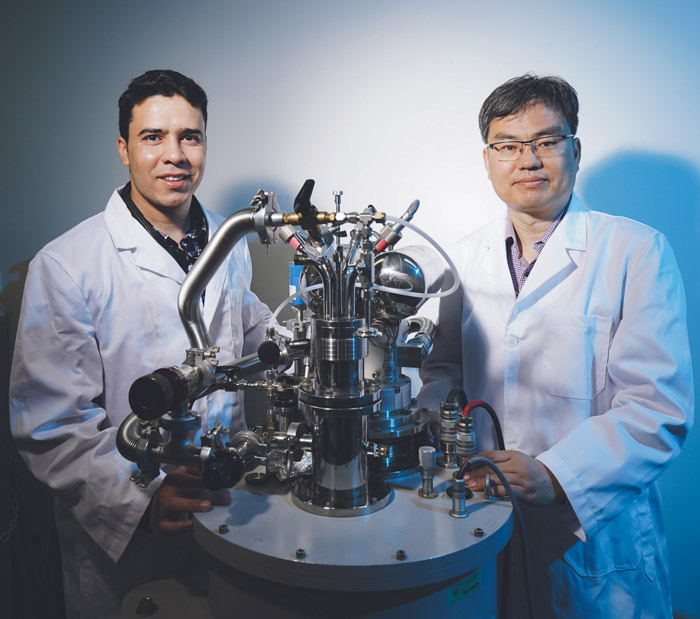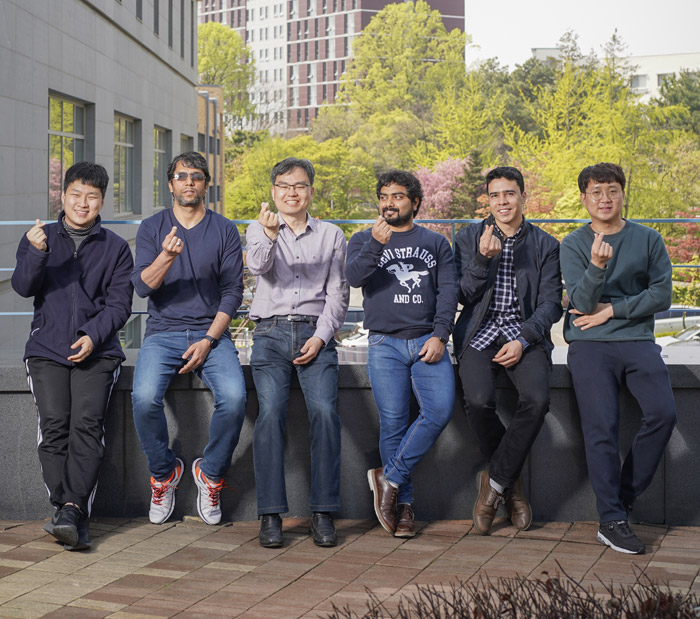Research Stories
Development of Advanced Concept Electronic Devices for THz Technology
The research team applied for a patent as a source of technology and expects it to be used in various areas such as high speed wireless communication in the THz area and high resolution AR/VR that require high-capacity video processing in the future.
Mechanical Engineering
Prof.
LEE, CHANG GU
Dr. Budhi Singh, Dr. Pawan Kumar Srivastava, Dr. Yasir Hassan
In recent years, numerous electronics engineers worldwide have been trying to develop new semiconductor heterostructure devices using atomically thin materials. Among the many devices that can fabricated using these materials are resonant tunnelling diodes, which typically consist of a quantum-well structure placed between two barrier layers.
Past research has shown that stacking two-dimensional (2D) layers that are twisted in relation to each other can enhance or suppress the interlayer coupling at their interface. This suppression or enhancement can in turn modulate the electronic, optical and mechanical properties of the resulting device.
For instance, some studies found that the intralayer current transport in small angle twisted bilayer graphene prompted some exotic phenomena, such as superconductivity and ferromagnetism. These observations inspired a fundamentally new approach to device engineering, known as ‘twistronics’ (i.e., twist electronics).
Researchers at Sungkyunkwan University in South Korea have recently carried out a study aimed at evaluating the potential of a twistronics design for developing resonant tunnelling diodes based on black phosphorus homostructures. The resulting twisted black phosphorus-based resonant tunneling diodes, presented in a paper published in Nature Electronics, exhibit a higher tunnelling conductance than resonant tunnelling diodes based on van der Waals heterostructures.
“Interlayer current transport through twisted junctions could also be an intriguing topic of research that has not yet been explored,” Budhi Singh, one of the researchers who carried out the study, said. “This motivated us to investigate interlayer current-transport behavior in twisted black phosphorus-based homostructures.”
In a series of laboratory experiments, Singh and his research team identified a number of valuable features that characterize black phosphorus, including its highly anisotropic nature, a thickness-dependent workfunction/2D-carrier density and a twist angle-dependent interlayer coupling. The highly anisotropic nature of black phosphorus ultimately enables a vanishing interlayer coupling strength at specific twist angles.
“Interestingly, we found that the interlayer current-transport in such twisted junctions could be controlled even at higher twist angles,” Singh said. “The decoupled interface and momentum mismatch created through twisted Fermi surfaces could also affect the interlayer current-transport behavior and is a part of our primary investigation. In contrast, observation of exotic phenomena in intralayer current transport in twisted junctions is limited to smaller twist angles."
To evaluate the potential of the design strategy they devised, the researchers fabricated a black phosphorus tri-layer homojunction, by integrating a thin layer of black phosphorus between two thicker layers. The middle and thinner layer is twisted in relation to the top and bottom black phosphorus layers.
“Due to the twisted structure in our devices, the decoupled interfaces behave like a tunnel barrier for interlayer charge carrier transport,” Singh explained. “If we compare this structure with the conventional double barrier resonant tunnelling diode, middle black phosphorus serves as an analogue of the quantum well.”
In the device fabricated by Singh and his colleagues, the emergence of a negative differential resistance and the evolution of peak position with a varying thickness of the middle black phosphorus layer produced a signature typically associated with resonant tunnelling diodes. Resonant tunnelling occurs when the energy and momenta of the top and bottom black phosphorus layers match those of the quantum well states, due to processes of energy and momentum conservation.
“Whenever we talk about tunnelling phenomena, there has to be a physical barrier (i.e., materials with large energy bandgaps),” Singh said. “In general, this architecture is achieved in a heterostructures assembly, but we demonstrated resonant tunnelling through a homostructure without the need of any physical tunnel barrier.”
The twistronics design strategy introduced by Singh and his colleagues could soon inspire the fabrication of other devices that exhibit remarkable tunnelling conductance. In the device created by the researchers, the tunnelling mechanism is dominated by a twist-controlled interlayer coupling, which results in a high tunnelling current density. Their diode device and other twist-controlled tunnel devices with high current densities could ultimately be used to realize a variety of high speed electronics, including THz oscillators and ultrafast switches.
“In the near future, we would like to perform experiments to realize twisted black phosphorus homostructures in practical applications, such as THz devices and applications in superconducting spectroscopy.”
Image Captions:
Figure. (Left) Illustration of the twisted black phosphorus trilayer homojunction device in which a thin black phosphorus is 90o sandwiched between two thick black phosphorus. (Right) Interlayer tunnelling current (ID) through quantum well states revealed the characteristics of a resonant tunnelling diode.
References:
Resonant tunnelling diodes based on twisted black phosphorus homostructures. <i>Nature Electronics</i>(2021). DOI: 10.1038/s41928-021-00549-1.
https://www.nature.com/articles/s41928-021-00549-1


